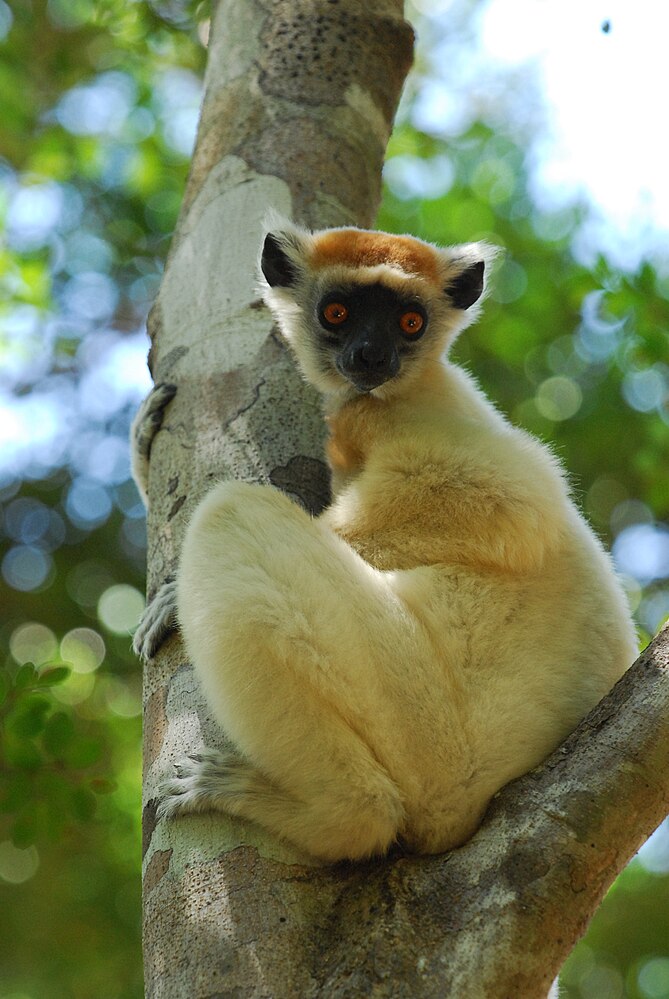How big does a Golden-crowned sifaka get? Here is an overview over the average adult age:
A grown Golden-crowned sifaka (Propithecus tattersalli) reaches an average size of 47.5 cm (1′ 7″).
When born, they have an average size of 0 cm (0′ 0″). A full-grown exemplary reaches roughly 3.53 kg (7.79 lbs). On birth they have a weight of 97 grams (0.21 lbs). The Golden-crowned sifaka (genus: Propithecus) is a member of the family Indridae.
As a reference: Humans reach an average body size of 1.65m (5′ 5″) while carrying 62 kg (137 lbs). A human woman is pregnant for 280 days (40 weeks) and on average become 75 years old.

The golden-crowned sifaka or Tattersall’s sifaka (Propithecus tattersalli) is a medium-sized lemur characterized by mostly white fur, prominent furry ears, and a golden-orange crown. It is one of the smallest sifakas (genus Propithecus), weighing around 3.5 kg (7.7 lb) and measuring approximately 90 cm (35 in) from head to tail. Like all sifakas, it is a vertical clinger and leaper, and its diet includes mostly seeds and leaves. The golden-crowned sifaka is named after its discoverer, Ian Tattersall, who first spotted the species in 1974. However, it was not formally described until 1988, after a research team led by Elwyn L. Simons observed and captured some specimens for captive breeding. The golden-crowned sifaka most closely resembles the western forest sifakas of the P. verreauxi group, yet its karyotype suggests a closer relationship with the P. diadema group of eastern forest sifakas. Despite the similarities with both groups, more recent studies of its karyotype support its classification as a distinct species.Found in gallery, deciduous, and semi-evergreen forest, its restricted range includes 44 forest fragments, totaling an area of 44,125 hectares (109,040 acres; 170.37 sq mi), centered on the town of Daraina in northeast Madagascar. Its estimated population is 18,000 individuals. It is primarily active during the day, although it also tends to be active at dawn and dusk during the rainy season. It sleeps in tall emergent trees and is preyed upon by the fossa. The golden-crowned sifaka lives in groups of around five to six individuals, containing a balanced number of adult males and females. Scent is used to mark territories, which are defended by growling, chasing, and ritualistic leaping displays. Reproduction is seasonal, with gestation lasting six months and lactation lasting five months. Infants are weaned during the wet season to ensure the best chances of survival.The small range and fragmented populations of this species weigh heavily on its survival. Forest fragmentation, habitat destruction, poaching, slash-and-burn agriculture, and other human factors threaten its existence. The golden-crowned sifaka is listed by the IUCN Red List as Critically Endangered. Its range was originally not covered by any national parks or protected areas in Madagascar, but a new protected area was established in 2005 to include a 20,000 ha (49,000 acres; 77 sq mi) portion. Attempts have been made to keep the golden-crowned sifaka in captivity at the Duke Lemur Center in Durham, North Carolina. The small colony was maintained from 1988 to 2008. In Madagascar, lawlessness resulting from the 2009 political coup led to increased poaching of this species, and many were sold to local restaurants as a delicacy.
Animals of the same family as a Golden-crowned sifaka
We found other animals of the Indridae family:
- Diademed sifaka with a size of 50.1 cm (1′ 8″)
- Verreaux’s sifaka with a size of 47.2 cm (1′ 7″)
- Eastern woolly lemur with a size of 27.5 cm (0′ 11″)
- Indri with a size of 73.4 cm (2′ 5″)
Animals with the same size as a Golden-crowned sifaka
Not that size really matters, but it makes things comparable. So here are a couple of animals that are as big as Golden-crowned sifaka:
- Vancouver Island marmot with a size of 46.7 cm (1′ 7″)
- Red-eared guenon with a size of 43.5 cm (1′ 6″)
- Flat-headed cat with a size of 46.7 cm (1′ 7″)
- Telefomin cuscus with a size of 39.9 cm (1′ 4″)
- White-thighed surili with a size of 51 cm (1′ 9″)
- White-sided jackrabbit with a size of 48.8 cm (1′ 8″)
- Yellow-tailed woolly monkey with a size of 55.1 cm (1′ 10″)
- Steppe polecat with a size of 43.5 cm (1′ 6″)
- Bat-eared fox with a size of 53.8 cm (1′ 10″)
- Chinese hare with a size of 38 cm (1′ 3″)
Animals with the same weight as a Golden-crowned sifaka
As a comparison, here are some other animals that weight as much as the Propithecus tattersalli:
- Bald uakari with a weight of 3.42 kilos (7.54 lbs)
- Black agouti with a weight of 3.5 kilos (7.72 lbs)
- Colombian white-faced capuchin with a weight of 3.01 kilos (6.64 lbs)
- Short-eared possum with a weight of 3.13 kilos (6.9 lbs)
- Golden-backed uakari with a weight of 3.13 kilos (6.9 lbs)
- Rock hyrax with a weight of 2.95 kilos (6.5 lbs)
- Hoary fox with a weight of 4.23 kilos (9.33 lbs)
- Fisher (animal) with a weight of 3.75 kilos (8.27 lbs)
- Gray fox with a weight of 3.83 kilos (8.44 lbs)
- Asian palm civet with a weight of 3.2 kilos (7.05 lbs)
